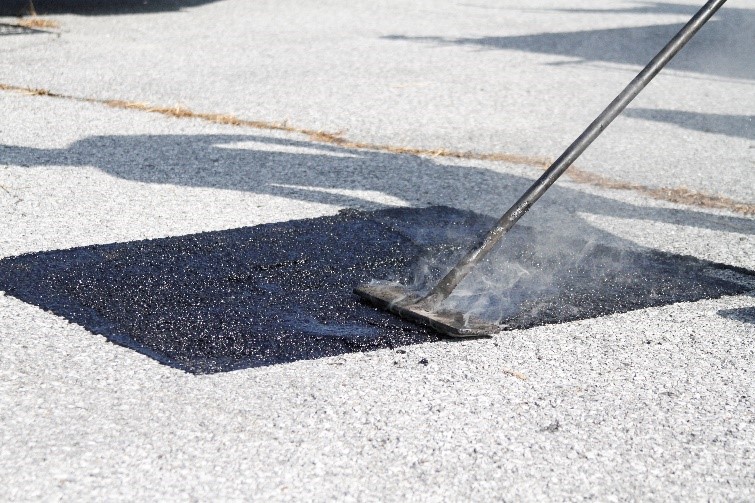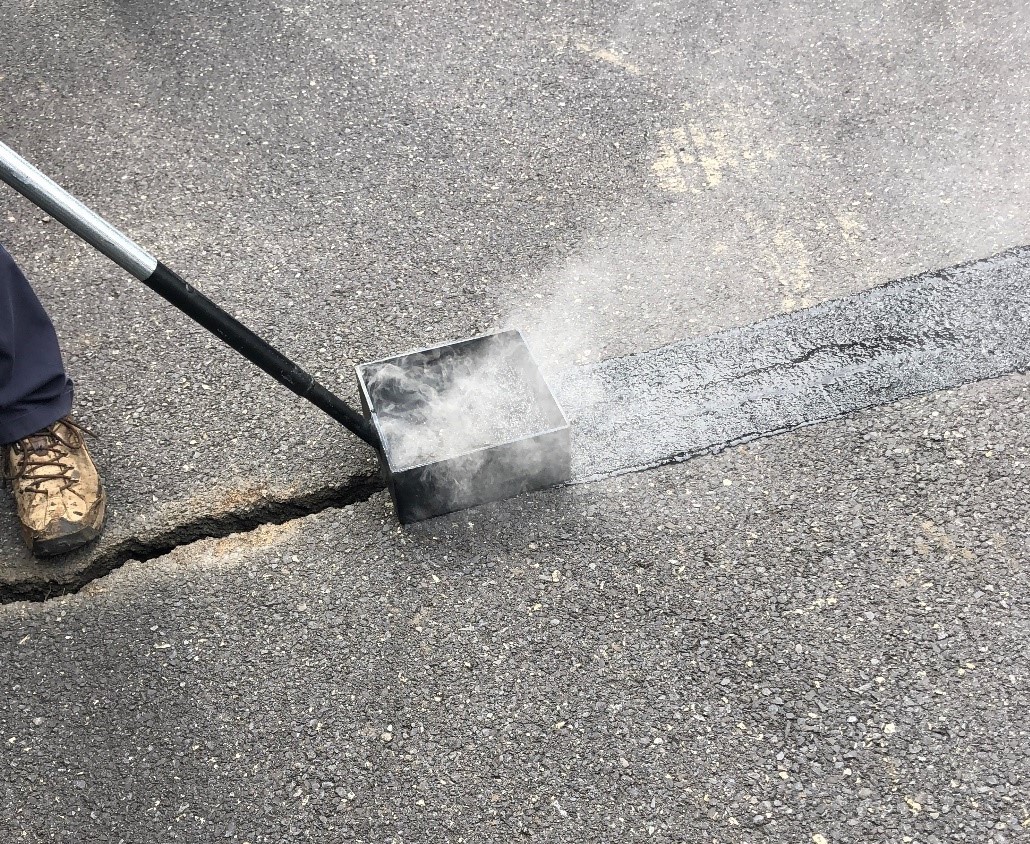Hot Pour Mastics
Hot Pour Mastics (HPM) provides a stable, flexible repair that bonds firmly with existing pavements. HPM can be used year-round as a one-time application for large cracks and small potholes on concrete and asphalt pavements when surface temperatures are 40 degrees Fahrenheit and rising.
How Does It Work?
By combining the flexibility and adhesion of rubberized asphalt sealants with the strength and load-bearing capabilities of engineered aggregates, HPM completely fills the repair void. The result provides an even repair that bonds firmly with existing pavements to seal out water, return structural strength, improve ride quality and prevent further damage.

Like crack sealing operations, the best times of year to use HPM are spring and fall, as cracks are open, and the mastic material takes less time to cool down and reopen the road to traffic. HPM repair areas must be readied to receive HPM by thoroughly cleaning the area of all loose material, vegetation, dust and debris, and drying the area. In cooler weather applications, the use of hot air lances, heated chutes and torches may be necessary, which will require additional labor, preparation work, and equipment.

The mastic is heated in a mastic melter, and moved from the melter by gravity flow or built-in screw auger. The auger allows the mix to be drawn down a chute or directly from the discharge opening. As the mastic melts, the binder and aggregates combine to form the proper blend.
Gravity flow is one of the simplest application methods. This technique uses metal five-gallon pails or a small shuttle buggy to precisely place the material onto the void to be repaired. Material can also be dropped from the rear of the melter into a hand toolbox screed. For larger repairs, drag boxes can be affixed to the rear of the melter under the discharge opening to allow for the material to be spread consistently over a continuous longitudinal crack.

Once the mastic is placed, it is smoothed over the surface area and edges of the repair using a hot steel plate hand tool that is heated in a side compartment of the mastic melter. The tool is used to reduce the rough and uneven surface of the repair.
Guidance on the use of HPM is available to all PennDOT districts. PennDOT’s Materials Testing Lab has "conditionally approved" four HPM manufacturers under PennDOT's New Products and Innovations (NPI) Section. PennDOT plans to monitor performance for two years before removing the "conditional approval" status. This "conditional approval" does not limit the use of the products, but allows PennDOT’s NPI Section to continue its evaluation based on field applications. These manufacturers include Crafco, Maxwell Products, Fibercrete and Right/Pointe. HPM can be found as a standalone category in the miscellaneous section of
PennDOT’s Bulletin 15 and can be used by counties and municipalities through
PennDOT’s Liquid Fuels Program.
What Are The Benefits?
HPM is a versatile and permanent material that remains flexible at lower temperatures, which leads to longer-lasting repairs. It requires minimal pavement preparation and allows for quicker application times, resulting in shorter traffic closures and delays for motorists.
This application has an extended cycle length over traditional, routine crack sealing for concrete and asphalt pavements. Use of HPM reduces labor, equipment and mobilization required to make maintenance repairs.
DID YOU KNOW... The STIC’s Maintenance TAG surveyed 30 state agencies about their use of HPM. Seventeen of those states responded that they currently use HPM for maintenance activities.
Innovation In Motion
HPM demonstrations have been performed in several PennDOT districts, and the technique has been used by PennDOT forces on maintenance projects in several PennDOT districts as well as a construction project in PennDOT's District 8.
In July 2019, the STIC, in coordination the with the Pennsylvania Association of Asphalt Materials Applicators (PAAMA), hosted a HPM demonstration on a parking lot near the PennDOT Materials Testing Lab in Harrisburg. Four vendors demonstrated their products for PennDOT, Pennsylvania Turnpike Commission and Federal Highway Administration representatives, as well as STIC members and local government officials. Attendees were able to observe application methods and ask questions of the technical experts.